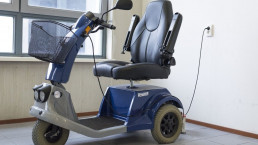
Power Chair Safety: Tips for Use in a Skilled Nursing Facility, at Home, and in the Community
A manual wheelchair could be assigned to just about anyone because it offers stationery use as well as voluntary self-propulsion at calm speeds.
When a motor is added, upgrading the seated contraption into a power chair, red flags should be popping up indicating serious safety precautions.
The user now has access to immediate self-propulsion with a jerk of the joystick, granting them high speeds for indoor and outdoor use.
If user receives appropriate training, then using the power chair provides enhanced and safe mobility around their home and their community.
However, if a power chair is handed to anyone with limited to zero training and with no consideration for physical/cognitive capabilities, the end result could be disastrous for the user and those in their surrounding environment.
The following are a few tips to promote safe use of a power chair in three settings: a skilled nursing facility, a private home, and in the community.
Consult with primary physician and specialists: Before you get “Click to Order” button-happy, consider the benefits of consulting with a specialist and undergoing an evaluation first.
Like a car, you would not allow a person with severe dementia or with bilateral glaucoma drive a motorized chair. If potential users, family members, or caregivers have concerns regarding vision, cognition, or any deficit that could lead to injury to the user or to others while operating the chair, make the wise decision to seek out a safety evaluation.
Participate in power chair use training: For patients who reside in a skilled nursing or long-term care setting, medical staff may be bound by specific policies regarding power chair evaluations and use.
For example, residents who receive a doctor’s order to be fitted for a power chair will have to undergo several steps including: a consultation with a wheelchair specialist and a rehabilitation therapist (usually occupational or physical therapy), training in a demo chair conducted by the therapist, and evaluations to obtain insurance coverage for the chair.
For persons who are buying the chair for private residential use, it is recommended to consult with a medical equipment specialist about correctly operating the chair for indoor and outdoor use.
Opt for a demo or a rental: If you live at home and/or you are worried about whether or not you can safely use a power chair in your living space, contact a medical equipment company about renting or borrowing a demo chair.
Rentals means delaying financial commitment to your own chair while providing you time to select a chair that fits your body type, fits in your home, and fits your daily needs for mobility at home and in the community.
Read the Instructions: Specifically, brush up on the user manual for the chair’s intended purposes. Too often, users attempt to propel power chairs over rough and unpredictable terrain when the chair was never designed for outdoor use.
If you need a chair for both indoor and outdoor use, thoroughly research power chairs that can meet your criteria to minimize damage to the chair and to yourself.
Prepare for the worst scenario: When going on a community outing with a power chair, be prepared for the worst circumstances: medical emergencies and chair stalling.
Wear weather-appropriate clothing to reduce exposure injuries. Bring plenty of water, snacks, and back-up medication. Have the chair battery fully charged before departing and bring the charger with you.
Pack a fully charged cellphone and the charger for complete emergency access. Always tell someone where you are going and when you plan on returning home.
Bring a chaperone with you: If you are new to using a power chair, don’t be shy and ask someone to supervise you. It could be for a simple jaunt around the facility, reversing out of a tight space, or taking a community outing.
Make sure that the chaperone fully understands that if the chair stalls or tips that it is not their responsibility to push or catch the chair. In order to avoid injury and to have complete access to emergency personnel, the chaperone is responsible for making the 9-1-1 call or recruiting others for assistance.
Subscribe for Alerts about New Availability in Your Area
Newsletter